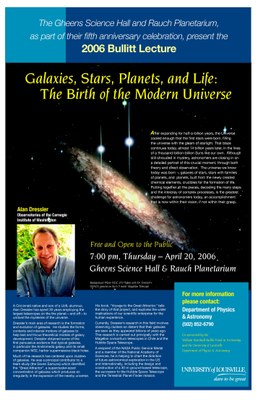Bullitt Lecture in Astronomy 2006 - Galaxies, Stars, Planets, and Life: The Birth of the Modern Universe
| When |
Apr 20, 2006
from 07:00 PM to 08:00 PM |
|---|---|
| Where | Gheens Science Hall & Rauch Planetarium |
| Contact Name | Gerard Williger, Ph.D. |
| Add event to calendar |
|
Speaker: Alan Dressler, Observatories of the Carnegie Institute of Washington
 Abstract: After expanding for half-a-billion years, the Universe cooled enough that the first stars were born, filling the universe with the gleam of starlight. That blaze continues today, almost 14 billion years later, in the lives of a thousand-billion-billion Suns like our own. Although still shrouded in mystery, astronomers are closing in on a detailed portrait of this crucial moment, through both theory and direct observation. The universe we know today was born -- galaxies of stars, stars with families of planets, and planets, built from the newly created chemical elements, crucibles for the formation of life. Putting together all the pieces, decoding the many steps and the interplay of complex processes, is the greatest challenge for astronomers today, an accomplishment that is now within their vision, if not within their grasp.
Abstract: After expanding for half-a-billion years, the Universe cooled enough that the first stars were born, filling the universe with the gleam of starlight. That blaze continues today, almost 14 billion years later, in the lives of a thousand-billion-billion Suns like our own. Although still shrouded in mystery, astronomers are closing in on a detailed portrait of this crucial moment, through both theory and direct observation. The universe we know today was born -- galaxies of stars, stars with families of planets, and planets, built from the newly created chemical elements, crucibles for the formation of life. Putting together all the pieces, decoding the many steps and the interplay of complex processes, is the greatest challenge for astronomers today, an accomplishment that is now within their vision, if not within their grasp.
A Cincinnati native a son of a UofL alumnus, Alan Dressler has spent 30 years employing the largest telescopes on the planet - and off - to unravel the mysteries of the universe. Dressler's main area of research is the formation and evolution of galaxies. He studies the forms, contents and internal motions of galaxies to help test and focus theoretical models of galaxy development. Dressler obtained some of the first persuasive evidence that typical galaxies, in particular the Andromeda galaxy and its small companion M32, harbor supermassive black holes. Much of his research has centered upon clusters of galaxies. He was a principal contributor to a team study (the Seven Samurai) which identified the "Great Attractor", a supercluter-sized concentration of galaxies which produces an irregularity in the expansion of the nearby universe. His book, "Voyage to the Great Attractor", tells the story of that project, and explores the wider implications of our scientific enterprise for the human experience. Currently, Dressler's research in this field involves observing clusters so distant that their galaxies are seen as they appeared billions of years ago. This research is carried out principally with the Magellan consortium telescopes in Chile and the Hubble Space Telescope. A recipient of the NASA Public Service Medal and a member if the National Academy of Sciences, he is helping to chart the direction of future astronomical exploration in the US and internationally, including the design and construction of a 30-m ground-based telescope, the successor to the Hubble Space Telescope and the Terrestrial Planet Finder mission.
